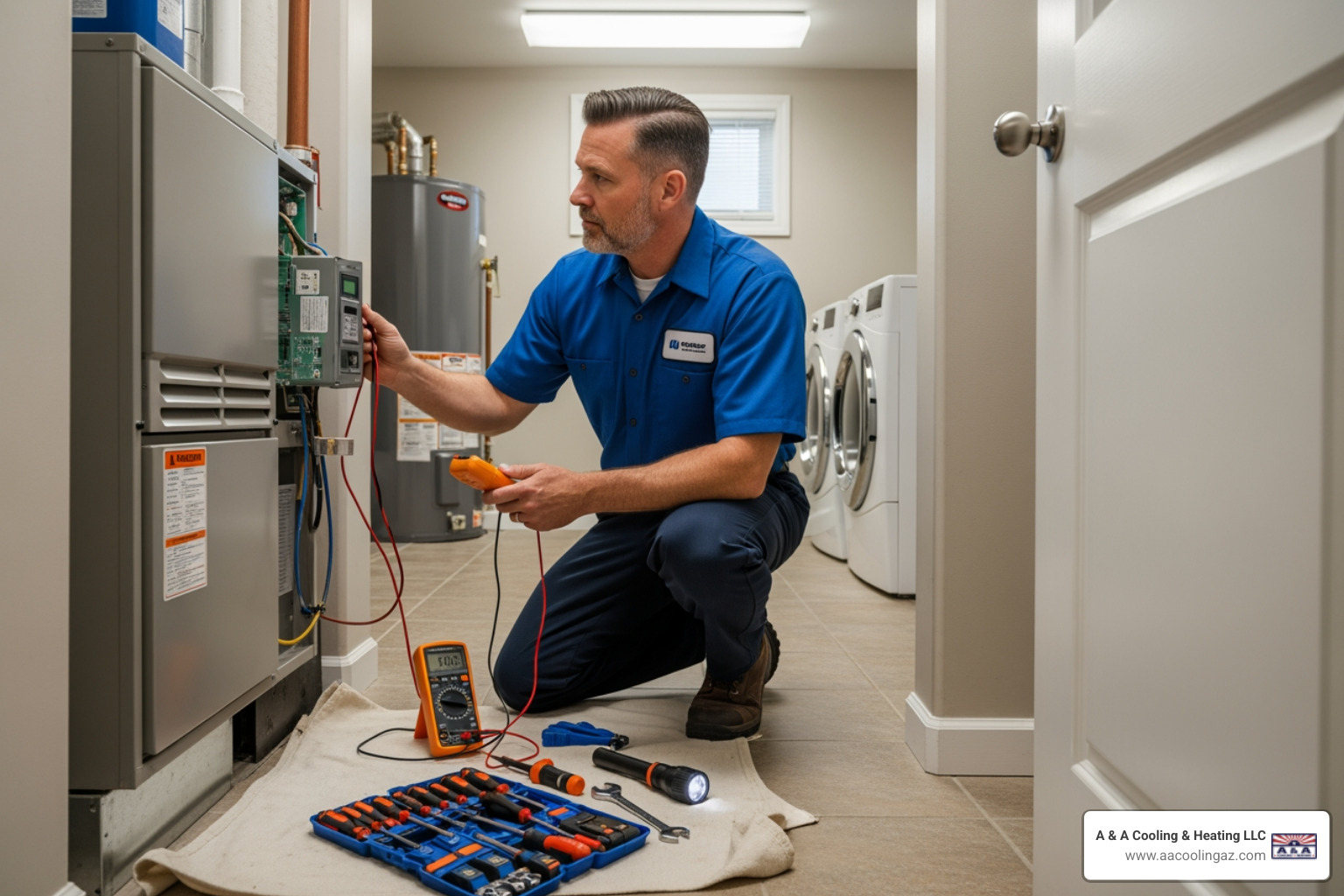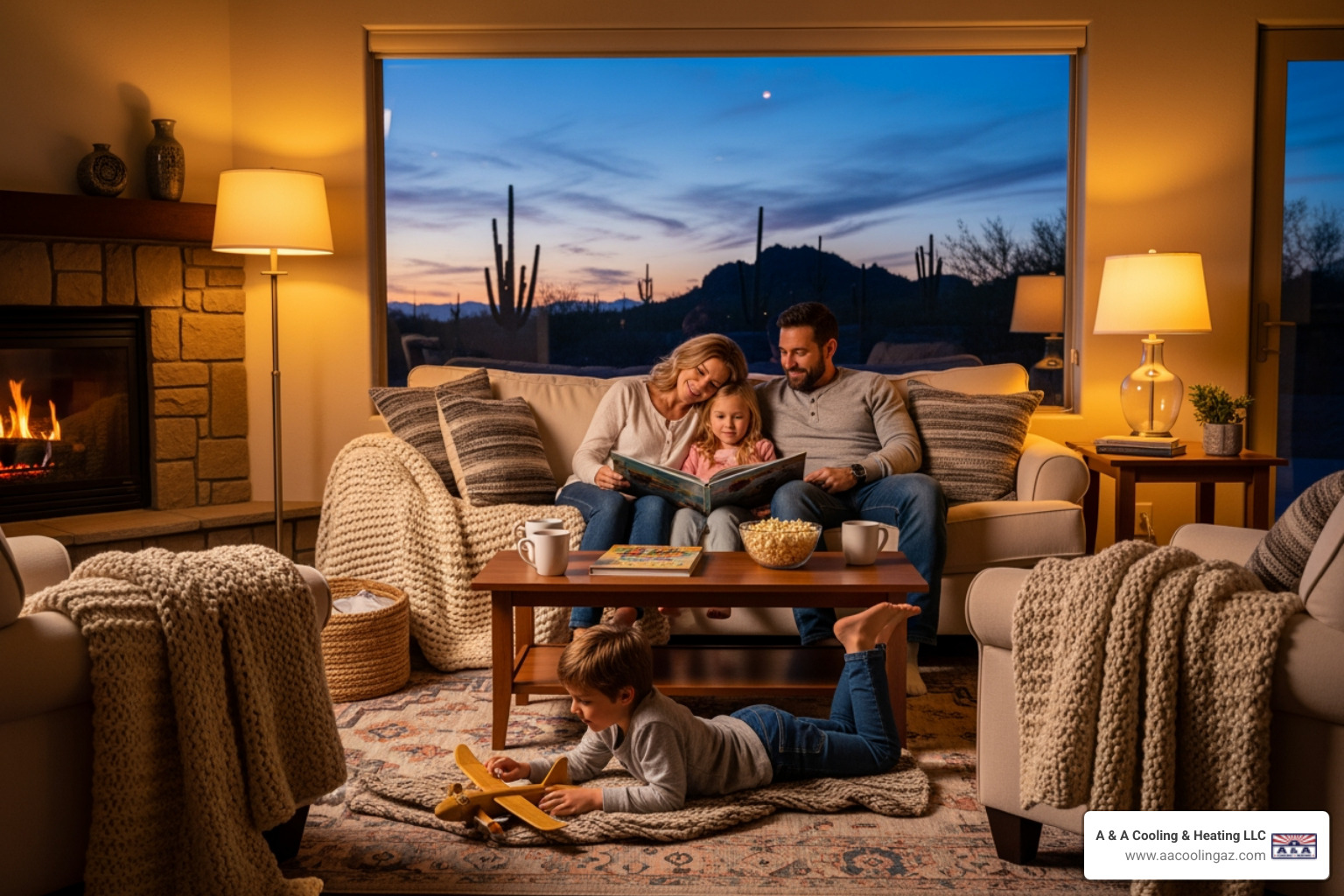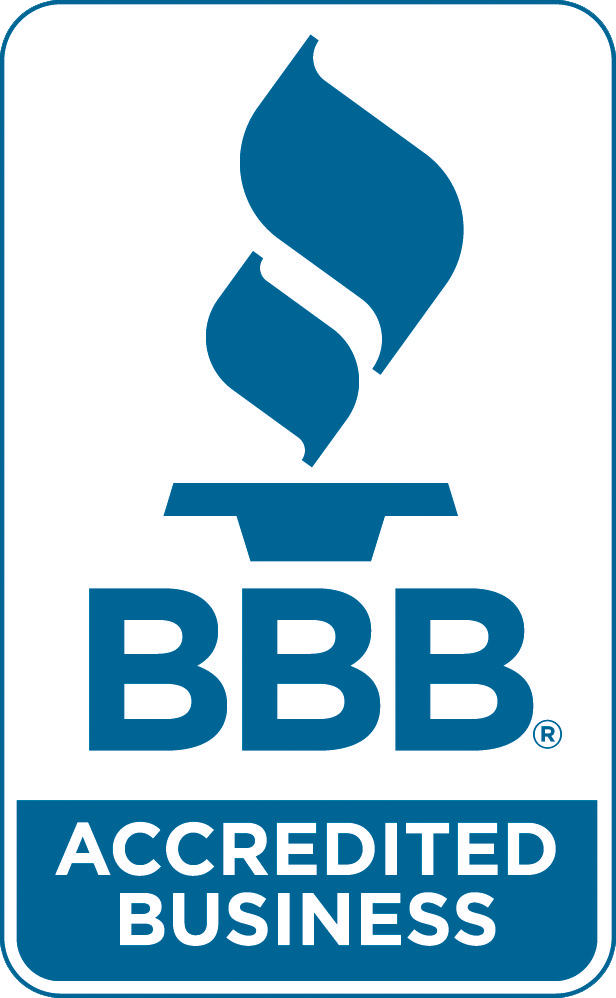Stay Warm: Quick Tips for Emergency Furnace and Heating Service
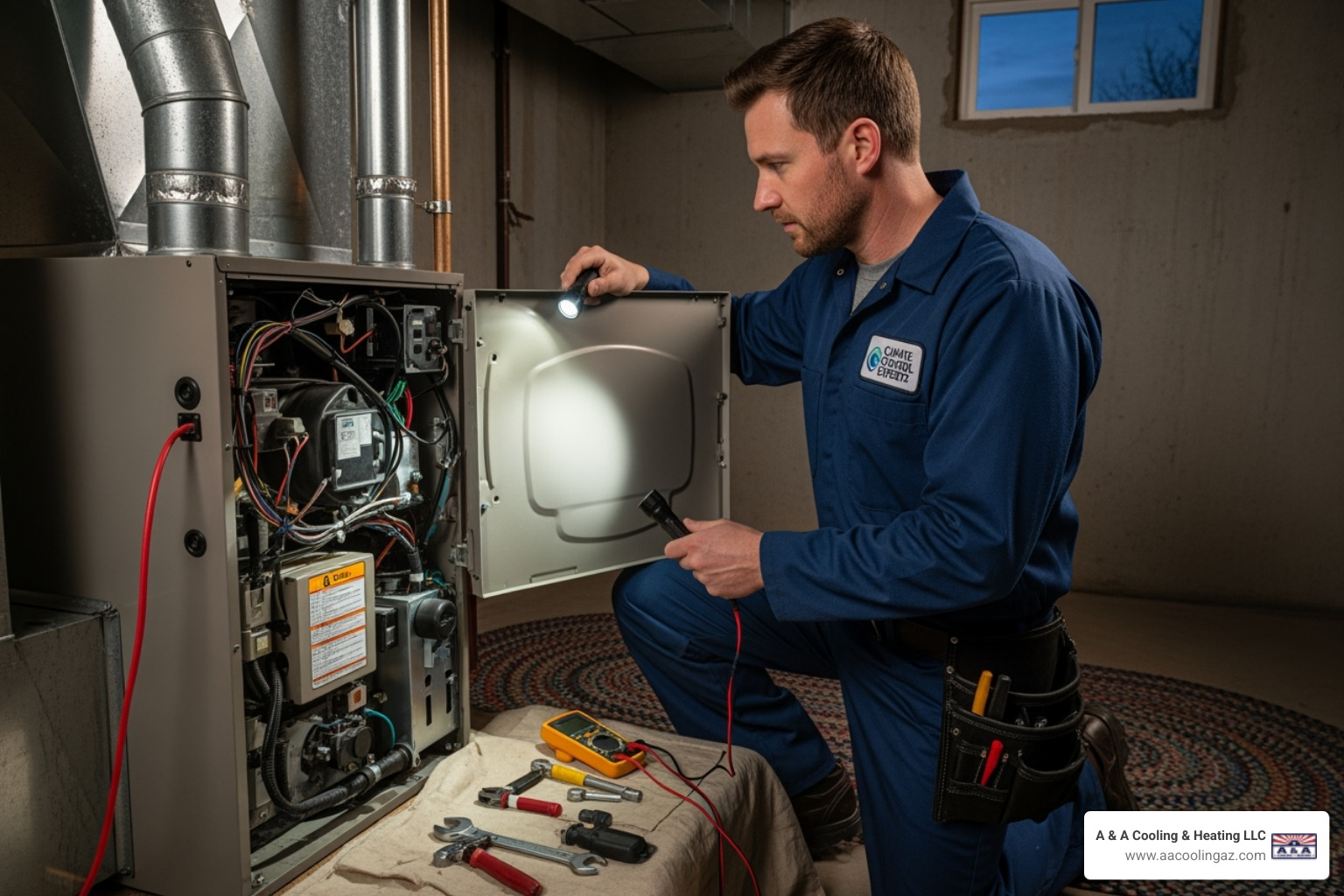
Introduction: When a Cold House Becomes a Crisis
Emergency heating service is a critical lifeline when your furnace fails in cold weather. A sudden loss of heat isn't just an inconvenience; it's a risk to your home's safety and your family's well-being.
Quick Action Steps for a Heating Emergency:
- Check your thermostat: Ensure it's set to "heat" and the temperature is set higher than the current room temperature.
- Verify power: Check the furnace disconnect switch and the circuit breaker.
- Inspect the filter: A severely clogged filter can shut the system down.
- Clear exterior vents: Remove any snow, debris, or other blockages.
- Call a professional: If these steps don't work, contact a 24/7 emergency heating service immediately.
According to the World Health Organization, homes should be kept at or above 18°C (about 64°F) to avoid health risks, especially for children and the elderly. A heating emergency can also signal dangerous underlying issues like carbon monoxide leaks, gas line problems, or electrical faults that require immediate professional attention.
Furnaces often fail at the worst times, like nights or holidays. That's why 24/7 emergency services that respond quickly, often within 30 minutes to a few hours, provide essential peace of mind.
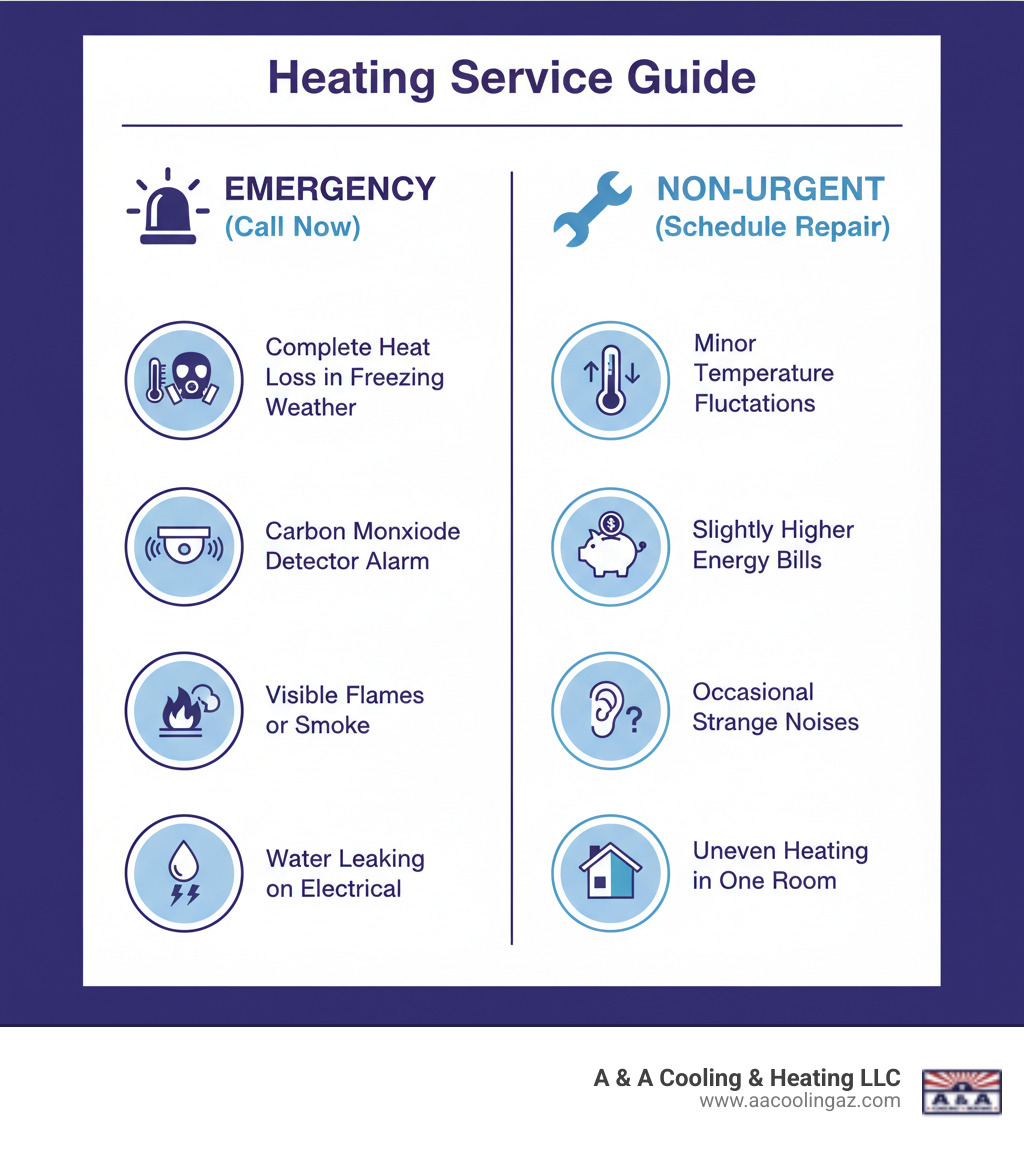
First Steps: What to Check Before You Call for Service
When your heat goes out, your first instinct is to call for help. While emergency heating service is essential for true crises, many issues can be resolved with a few simple checks. Before you call, take five minutes to troubleshoot these common culprits—it might save you a service call and restore your heat right away.

Is Your Thermostat Set Correctly?
Your thermostat controls your entire heating system, so start there.
- Mode: Make sure it's set to "Heat." It's easy to forget to switch it from "Cool" when the seasons change.
- Temperature: The set temperature must be at least five degrees higher than the current room temperature to trigger the furnace.
- Fan Setting: Set the fan to "Auto," not "On." The "On" setting makes the fan blow constantly, even when the furnace isn't heating, which can make you feel cold air.
- Batteries: If your thermostat has a dim or blank display, try replacing the batteries.
- Smart Thermostat: If you have a smart thermostat that's malfunctioning, try rebooting it through its menu or by temporarily cutting its power.
Simple Safety and Power Checks
If the thermostat settings are correct, check the furnace's power and safety features.
- Furnace Disconnect Switch: This switch, which looks like a light switch, is usually on or near the furnace. Ensure it's in the "On" position, as it can be bumped off by accident.
- Circuit Breaker: Find the breaker for your furnace in your home's electrical panel. If it has tripped (it will be in the middle position or look loose), flip it completely off and then firmly back to "On."
- Pilot Light: If you have an older gas furnace, check if the pilot light—a small blue flame—is lit. If it's out, your furnace won't ignite. Some have a re-ignition button, but if it repeatedly goes out, you need a professional.
- Gas Supply Valve: Near your furnace, a valve handle on the gas line should be parallel to the pipe, indicating gas is flowing. If it's perpendicular, it's off. If you smell gas (a rotten egg odor), leave your home immediately and call for help.
- Air Filter: A clogged air filter is a very common cause of furnace shutdowns. If you can't see light through it, it's time for a replacement.
- Exterior Vents: Check outside for blocked intake and exhaust vents. Snow, leaves, or debris can obstruct airflow and shut your system down.
If you've gone through these steps and still have no heat, it's time to call for professional emergency heating service.
Common Problems That Require an Emergency Heating Service
Some heating problems are more than simple fixes and require an emergency heating service. These issues often involve core components failing in ways that can compromise your safety and comfort.
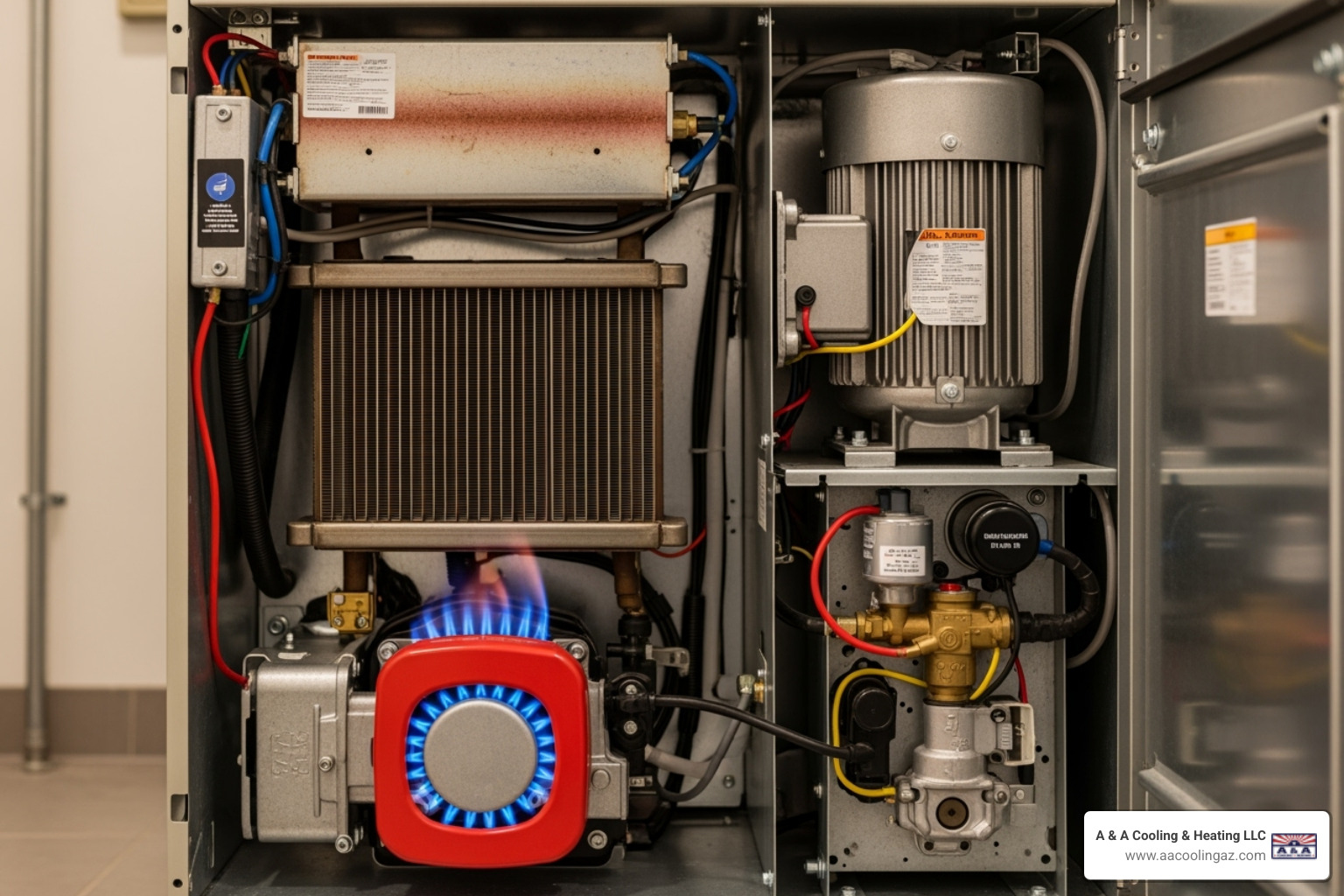
If your furnace stops producing any heat, the issue is likely with a major component. Ignition system failure is a frequent culprit; a faulty flame sensor, bad ignition board, or low gas pressure can prevent the furnace from lighting. The blower motor, which circulates warm air, can also fail. If it does, you may feel weak or no airflow from your vents. In older systems, a broken belt on the blower can stop air circulation entirely.
A more serious issue is a malfunctioning heat exchanger. If this component cracks, it can leak dangerous carbon monoxide into your home. This is a true emergency that often requires replacement of the unit. Likewise, gas line problems and electrical faults (like a bad capacitor or control board) are not DIY jobs and demand expert diagnosis to ensure safety.
Understanding Strange Noises and Smells
Your furnace often signals problems with unusual sounds and odors.
- Banging or Popping: A loud bang when the furnace starts often indicates delayed ignition, where gas builds up before igniting. This is dangerous and needs immediate attention.
- Screeching or Grinding: These high-pitched noises usually point to a problem with the blower motor, such as worn-out bearings. Addressing this quickly can prevent complete motor failure.
- Burning Smell: While a dusty smell is normal for the first run of the season, a persistent burning odor or the smell of hot plastic or rubber suggests an electrical problem or an overheating part.
- Rotten Egg Smell: This indicates a gas leak. Evacuate your home immediately and call your gas company and an HVAC professional from a safe location.
- Carbon Monoxide: This deadly gas is odorless and invisible. If your CO detector alarms, get everyone out of the house immediately and call for help. North American Technician Excellence (NATE) certified professionals can diagnose these issues safely.
Why Your Furnace Keeps Shutting Off (Short Cycling)
If your furnace runs for only a few minutes before shutting off, it's short cycling. This puts extra wear on your system and increases energy bills. A furnace should cycle three to eight times per hour.
Overheating is a primary cause, often due to restricted airflow from a clogged air filter or blocked vents. A safety sensor shuts the furnace down to prevent damage. A malfunctioning thermostat can also send incorrect signals, causing premature shutdowns. In some cases, the furnace is simply too large for the home (incorrect furnace size), causing it to heat the space too quickly and shut off, only to restart again moments later. Addressing short cycling promptly can save money and extend your furnace's lifespan.
What to Expect from a 24/7 Repair Service
When your heat fails after hours, you need a service that's always available. At A & A Cooling & Heating LLC, our 24/7 emergency heating service means you'll talk to a real person, day or night, who can dispatch a technician to your home.
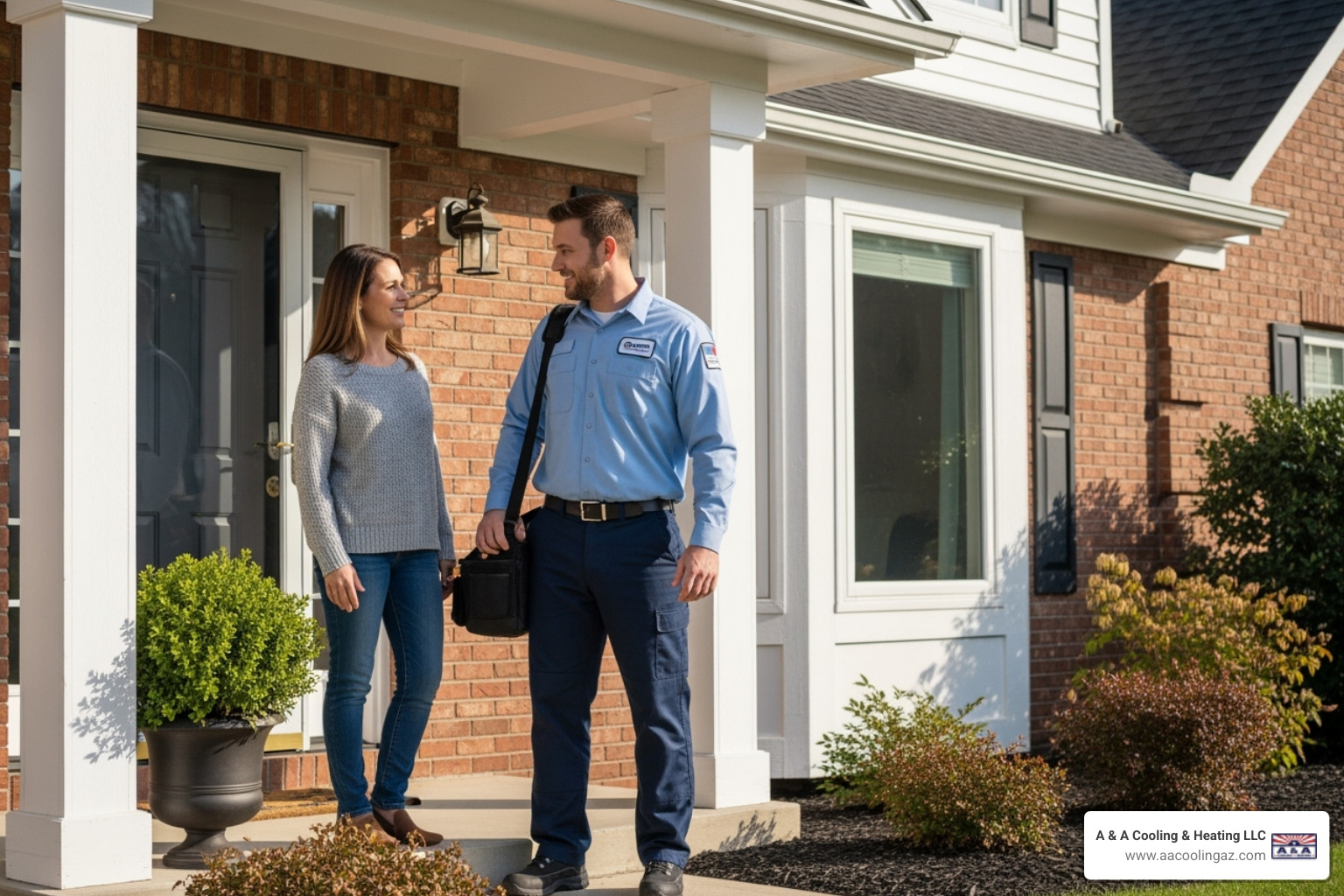
We pride ourselves on rapid response times, aiming to arrive within 30 minutes to 4 hours. Our licensed technician will perform a full diagnostic inspection to find the exact cause of the problem. Our service vehicles are stocked with common replacement parts, so we can often complete the repair in a single visit. Every emergency call also includes a safety inspection to check for carbon monoxide risks and other hazards, ensuring your system is running safely. We provide clear explanations throughout the process, so you're never left in the dark.
How to Prepare for Your Emergency Heating Service Call
To help us resolve your issue faster, have this information ready when you call:
- Furnace make and model: Usually found on a sticker on the unit.
- Age of the system: An estimate is helpful if you don't know the exact age.
- Description of the problem: Note any strange noises, smells, or behaviors (like short cycling).
- Error codes: If your furnace display is flashing a code, write it down.
- Troubleshooting steps you've tried: Let us know if you've already checked the filter, thermostat, or breaker.
When Repair Isn't Enough: Signs You Need a Replacement
Sometimes, replacement is a more practical solution than another repair. Here are signs it might be time for a new furnace:
- Age: Most furnaces last 15-20 years. If yours is in this range and needs a major repair, replacement is often the smarter investment.
- Frequent Repairs: If you're calling for service every winter, the cumulative cost may justify a new, reliable system.
- Rising Energy Bills: A steady increase in your heating costs can signal that your furnace is losing efficiency.
- Uneven Heating: Cold spots in your home can mean your furnace is no longer able to distribute heat effectively.
- Visible Damage: Significant rust, corrosion, or cracks (especially on the heat exchanger) are serious safety concerns that typically warrant replacement.
When we recommend replacement during an emergency heating service call, we'll explain why and discuss all your options, helping you make an informed decision for your home and budget.
Preventing Future Emergencies with Proactive Care
The best emergency heating service call is the one you never have to make. Proactive care, much like regular oil changes for your car, is the key to preventing unexpected furnace breakdowns on the coldest nights.
Regular maintenance offers several key benefits. It extends your system's lifespan, helping it reach the 15-20 year mark. It also improves energy efficiency, as a clean, well-tuned furnace uses less fuel to heat your home, lowering your monthly bills. Most importantly, it ensures your family's safety. During a tune-up, technicians inspect for gas leaks, test for carbon monoxide, and check electrical connections to catch potential hazards before they become dangerous.
Knowing your system has been professionally serviced provides peace of mind and reliability all winter long. During a visit, we check thermostat calibration, clean or replace the filter, inspect blower components, tighten electrical connections, lubricate moving parts, and test all safety controls. This comprehensive check-up addresses the most common causes of furnace failure.
The Value of a Maintenance Plan
Our Cool Club maintenance plan makes preventative care simple. We take the worry off your plate so you can enjoy consistent comfort.
- Scheduled Inspections: We contact you to schedule your annual tune-up before the heating season begins, so you don't have to remember.
- Priority Service: If you do need an emergency heating service, Cool Club members receive priority scheduling to get you comfortable faster.
- Comprehensive Cleaning: We thoroughly clean internal components like the blower, coils, and burners to improve efficiency and prevent overheating.
- Safety Checks: Every visit includes tightening electrical connections, lubricating moving parts, and performing thorough safety inspections for carbon monoxide and gas leaks.
Since 1976, we've seen how regular maintenance helps homeowners avoid crises. A maintenance plan is an investment in reliability, lower energy bills, and peace of mind.
Frequently Asked Questions about Emergency Heating
When you're facing a heating crisis, you're bound to have questions. As a trusted service provider in Apache Junction since 1976, we've answered them all. Here are the most common questions we get about emergency heating service.
What is considered a heating emergency?
A heating emergency is any situation where a malfunctioning system poses an immediate threat to your health, safety, or home. This isn't a minor issue; it's a critical failure requiring a professional response. Key examples include:
- A complete loss of heat during freezing temperatures. The World Health Organization recommends indoor temperatures of at least 18°C (64°F) to avoid health risks.
- A suspected gas leak. If you smell rotten eggs, evacuate immediately and call your gas company and an HVAC professional from a safe location.
- A carbon monoxide detector alarm. This is a life-threatening emergency. Evacuate everyone from the home and call 911.
- Visible flames, smoke, or water leaking onto electrical parts. These are fire and shock hazards that need immediate attention.
Can I fix my furnace myself?
We encourage homeowners to perform basic troubleshooting, such as checking the thermostat, air filter, and circuit breaker. These simple steps are safe and often solve the problem. However, for any repairs beyond that, you should call a licensed professional. Furnaces contain complex electrical components and pressurized gas lines. Attempting DIY repairs without proper training creates a serious risk of electrical shock, gas leaks, or carbon monoxide poisoning. Furthermore, DIY repairs will likely void your furnace's warranty, leaving you responsible for the full cost of any future damage. For your safety and your system's integrity, it's always best to rely on professional emergency heating service.
How long can a house stay warm without heat?
This depends on several factors. The outdoor temperature is the most significant; a home will get dangerously cold much faster in freezing weather. Your home's insulation quality, including windows and weather stripping, also plays a major role in how long it retains heat. A well-insulated home might stay comfortable for 8-12 hours, but a poorly insulated one can become unsafe much more quickly. Because the temperature can drop rapidly, it's crucial not to wait. Contacting an emergency heating service promptly is the best way to restore warmth and ensure your family's safety.
Conclusion: Your Partner in Home Comfort and Safety
When your heating fails, you don't have to face the stress alone. Knowing the difference between a simple fix and a true emergency helps you respond quickly to protect your family and home. While many emergencies are preventable with regular maintenance, some crises are unavoidable.
Since 1976, A & A Cooling & Heating LLC has been committed to keeping our community safe and comfortable. Whether you need a routine tune-up through our Cool Club maintenance plan or an urgent emergency heating service call in the middle of the night, our team is ready to help. We understand you need a partner who responds quickly with care and expertise.
Your heating system is essential for your family's well-being. When something goes wrong, you can trust us to make it right.
Stay warm and safe with reliable heating services in Apache Junction, AZ. We're here for you 24/7.







